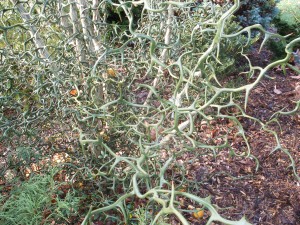Trifoliate orange (Poncirus trifoliata) is a hardy citrus native to China. T-orange is hardy to -15° F. This strong growing large shrub or small tree can reach 15 to 20 feet in height. Its foliage is deciduous and compound, compared to citrus trees with single simple evergreen leaves.
T-orange prefers full day or partial (minimum of 6 hours) sunlight. After one year establishment, it can cope with moderate periods of drought. T-orange grows in a soil pH range between 6.2 to 7.5 in average well-drained soils. One 3-4 oz. annual application of 10-10-10 granular fertilizer per plant in late winter provides adequate nutrition.
Showy 1 ½ to 2 inch white, mildly fragrant flowers open from late April into early May in the Southern Appalachian region (USDA zones 6 and 7). Golf ball sized green fruits turn rusty yellow (not orange) in late summer and are quite aromatic. The bitter fruits are edible and loaded with seeds.
Numerous heavy- duty, 1-2 inch long spines (thorns) form along deep green stems. The dominant spines seem to attract plant buyers to this “Little Shop of Horrors”. Plant it as a hedge to deter trespassers, if that is something you need to do. Aggressive pruning or shearing shapes and limits its size, but be advised to wear thick protective gloves and pack some extra band-aids.
T-orange is used as a winter hardy rootstock in commercial citrus groves. Some concern has been raised of its potential invasiveness.
‘Flying Dragon’ is a dwarf form with stems and thorns contorted or twisted. It grows well in pot culture.


 Posted in
Posted in 

Can anyone give me some tips for growing fuschias or reccommend other easy to grow plants from cuttings? I have a greenhouse for propogation.
Fuschias are propagated from soft tip cuttings dipped in a rooting hormone such as Rootone. Set 3-5 inch long cuttings in moist 80:20 perlite:peat moss mix and mist lightly 10-20 seconds every 4-5 minutes during the daylight hours. This may be your difficulty, the greenhouse environment. A mist system on a solenoid/time clock system is your best option, and available for sale on-line or greenhouse supply companies and farm cooperatives located in moderate sized cities. Your local Extension office will assist…Hugh